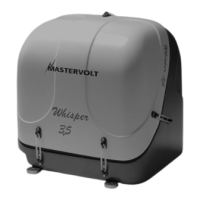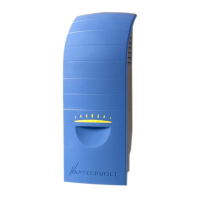INSTALLATION
EN/ Whisper 6/8/12/16 Ultra for mobile applications / May 2009 / Copyright © 2009 Mastervolt 15
Figure 15: Ventilating an air trap
Special attention should be paid to the ventilation of the
systems. Each installation system is standard supplied
with an expansion tank for the coolant, which is also used
to release air bubbles and makes it possible to add coolant
into the system in an easy way. This expansion tank
should be at the highest point of the system and mounted
as high as possible.
Most cooling problems originate from air traps
blocking the circulation of the engine coolant.
Figure 16. Alternator cooling system: open expansion tank
with overflow pillar.
For the alternator cooling system we use an open -non
pressurised- system. Therefore the 12 mm overflow pillar
on the expansion tank should stay open (figure 16). A
piece of hose can be used to drain redundant liquid that is
thrown out because of the expansion of the liquid in the
system. When open the expansion tank can easily release
air that is ventilated by the different connections. As the
capacity of the alternator cooling system is very small, also
the initial filling can be done via the expansion tank. It
could be necessary to refill the tank a few times. The
pump of the alternator cooling system is self-priming and
this makes the system less sensitive for air traps.
For cooling of the the engine we use a pressurised
system. The 12 mm connection on the top is closed.
Wherever the radiators are mounted it is necessary to
ventilate the exhaust manifold of the engine. The exhaust
manifold has a 8 mm connection to ventilate the manifold.
There is an 8 mm high pressure and high temperature
resistant hose in the delivery to connect the hose
connection on the side of the manifold with the expansion
tank. (refer to figure 7 till 10).
Initially the engine cooling system can be filled via the cap
on the exhaust manifold of the engine. However when the
radiator is above the engine one can only fill the system to
the level of the manifold. Additional filling has to be done
via the expansion tank.
For large engine cooling systems with long pipes or for
extra reserve there is an extra large expansion tank with a
content of 7 litres and an alarm for low coolant level that
can be supplied as an option (refer to figure 16).
Figure 17:
7 litres optional expansion tank with low level alarm.

